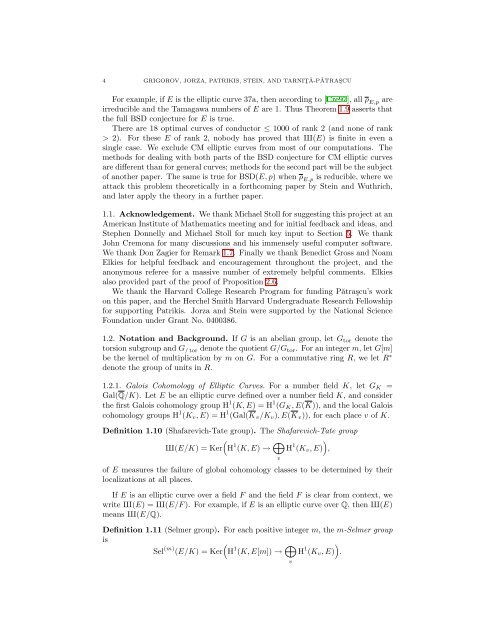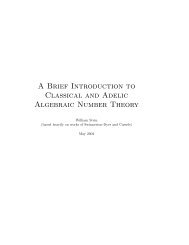COMPUTATIONAL VERIFICATION OF THE BIRCH ... - William Stein
COMPUTATIONAL VERIFICATION OF THE BIRCH ... - William Stein
COMPUTATIONAL VERIFICATION OF THE BIRCH ... - William Stein
Create successful ePaper yourself
Turn your PDF publications into a flip-book with our unique Google optimized e-Paper software.
4 GRIGOROV, JORZA, PATRIKIS, STEIN, AND TARNIT¸ Ǎ-PǍTRAS¸CU<br />
For example, if E is the elliptic curve 37a, then according to [Cre97], all ρ E,p are<br />
irreducible and the Tamagawa numbers of E are 1. Thus Theorem 1.9 asserts that<br />
the full BSD conjecture for E is true.<br />
There are 18 optimal curves of conductor ≤ 1000 of rank 2 (and none of rank<br />
> 2). For these E of rank 2, nobody has proved that X(E) is finite in even a<br />
single case. We exclude CM elliptic curves from most of our computations. The<br />
methods for dealing with both parts of the BSD conjecture for CM elliptic curves<br />
are different than for general curves; methods for the second part will be the subject<br />
of another paper. The same is true for BSD(E, p) when ρ E,p is reducible, where we<br />
attack this problem theoretically in a forthcoming paper by <strong>Stein</strong> and Wuthrich,<br />
and later apply the theory in a further paper.<br />
1.1. Acknowledgement. We thank Michael Stoll for suggesting this project at an<br />
American Institute of Mathematics meeting and for initial feedback and ideas, and<br />
Stephen Donnelly and Michael Stoll for much key input to Section 5. We thank<br />
John Cremona for many discussions and his immensely useful computer software.<br />
We thank Don Zagier for Remark 1.7. Finally we thank Benedict Gross and Noam<br />
Elkies for helpful feedback and encouragement throughout the project, and the<br />
anonymous referee for a massive number of extremely helpful comments. Elkies<br />
also provided part of the proof of Proposition 2.6.<br />
We thank the Harvard College Research Program for funding Pătra¸scu’s work<br />
on this paper, and the Herchel Smith Harvard Undergraduate Research Fellowship<br />
for supporting Patrikis. Jorza and <strong>Stein</strong> were supported by the National Science<br />
Foundation under Grant No. 0400386.<br />
1.2. Notation and Background. If G is an abelian group, let Gtor denote the<br />
torsion subgroup and G / tor denote the quotient G/Gtor. For an integer m, let G[m]<br />
be the kernel of multiplication by m on G. For a commutative ring R, we let R ∗<br />
denote the group of units in R.<br />
1.2.1. Galois Cohomology of Elliptic Curves. For a number field K, let GK =<br />
Gal(Q/K). Let E be an elliptic curve defined over a number field K, and consider<br />
the first Galois cohomology group H 1 (K, E) = H 1 (GK, E(K)), and the local Galois<br />
cohomology groups H 1 (Kv, E) = H 1 (Gal(Kv/Kv), E(Kv)), for each place v of K.<br />
Definition 1.10 (Shafarevich-Tate group). The Shafarevich-Tate group<br />
<br />
X(E/K) = Ker H 1 (K, E) → <br />
H 1 <br />
(Kv, E) ,<br />
of E measures the failure of global cohomology classes to be determined by their<br />
localizations at all places.<br />
If E is an elliptic curve over a field F and the field F is clear from context, we<br />
write X(E) = X(E/F ). For example, if E is an elliptic curve over Q, then X(E)<br />
means X(E/Q).<br />
Definition 1.11 (Selmer group). For each positive integer m, the m-Selmer group<br />
is<br />
Sel (m) <br />
(E/K) = Ker H 1 (K, E[m]) → <br />
H 1 <br />
(Kv, E) .<br />
v<br />
v
















